Best Dog Foods for Allergies

DogFoodAdvisor is reader supported See how
All reviews are 100% impartial but if you buy using links on this page, we may earn a referral fee.
On this page, The Dog Food Advisor takes an in-depth look at the best dog foods for allergies in 2024.
Plus… we’ll also review and rate each of our top picks.
But first…
What Types of Dog Food
Are Best for Allergies?
The best dog foods for allergies are available in 2 recipe designs:
- Limited ingredient diets
- Hypoallergenic dog foods
Limited Ingredient Diets
Limited ingredient diets contain fewer items, which can make it easier to pin down the specific ingredient (known as an allergen) to which your pet may be allergic.
Hypoallergenic Dog Foods
Hypoallergenic dog foods are different. They’re made with protein that’s been “split” into its basic nutrient building blocks. This “hydrolyzed” protein can make the allergen virtually invisible to your pet’s immune system.
So, your dog is less likely to have an allergic reaction to the food.
The Most Common
Food Allergens in Dogs
According to veterinarians at VCA Hospitals…
The 6 most common food allergens in dogs include beef, chicken, chicken eggs, dairy, soy and wheat gluten.
Our Editor’s Top Picks
On the page below…
We’ll share The Advisor’s best dog foods for allergies. And we’ll show you which ones are suitable for the age and breed size of your particular pet.
We’ll also answer the most frequently asked questions we get about choosing and feeding limited ingredient and hypoallergenic diets.
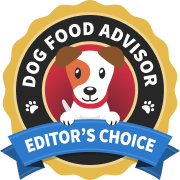
Best Dog Foods for Allergies April 2024
-
1. The Farmer's Dog (Pork)
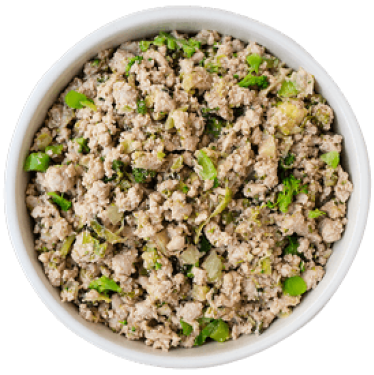
Farmers Pork is one of 3 fresh recipes included in our review of the The Farmers Dog product line.
The Farmer’s Dog pork recipe gets the bulk of its animal protein from fresh pork. Our dry matter label analysis reveals the recipe contains 36% protein, 28% fat and 28% estimated carbs… which produces a fat-to-protein ratio of about 78%.
A top pick. Enthusiastically recommended.
Read our review of the full The Farmer’s Dog Food (Fresh) range here
Main Ingredients Pork, sweet potato, potato, green beans, cauliflower Type Grain-free Protein Percentage 36% AAFCO Standards All Life Stages Best For All dogs including large breed puppies -
2. Nom Nom Fresh (Pork recipe)
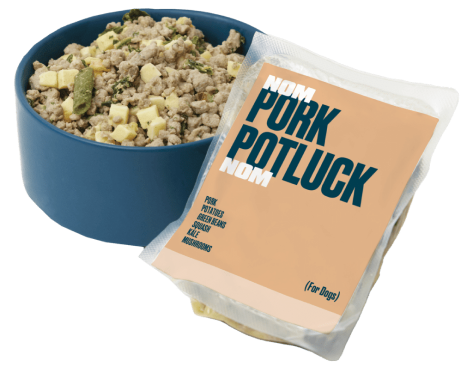
Pork Potluck is one of 4 fresh human-grade recipes studied in our review of the Nom Nom cooked-then-frozen product line.
Nom Nom Pork Potluck derives the bulk of its meat protein from fresh ground pork. Dry matter label analysis reveals a wet recipe containing 28% protein, 20% fat and 44% estimated carbs… with a fat-to-protein ratio of about 71%.
If you’ve ever wished you could feed your dog a fresh, home-cooked meal… but you didn’t know how to make sure it was nutritionally complete and balanced… then Nom Nom makes a smart choice.
The first time you visit Nom Nom’s website, you’ll answer a few questions about your dog’s age, weight, breed and suspected allergies. Nom Nom will then create a customized, single protein diet designed to keep your dog at optimal weight.
Expertly designed by Dr. Justin Shmalberg, a board-certified veterinary nutritionist (DACVN).
An excellent limited ingredient recipe… and a solid place to start an at-home elimination diet. Enthusiastically recommended.
For More Choices: See our Best Fresh-Cooked Dog Food page
Read our review of the full Nom Nom Dog Food (Fresh) range here
Main Ingredients Ground pork, russet potatoes, green beans, squash, kale Type Grain-free Protein Percentage 28% AAFCO Standards All life stages Best For Adults + puppies (including large breeds) -
3. Wellness Simple Limited Ingredient Diet
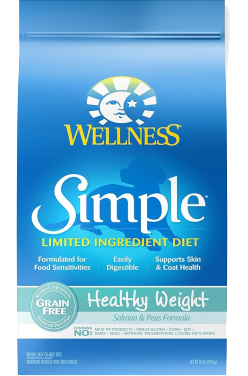
Turkey and Potato Formula is one of 6 recipes included in our review of the Wellness Simple Limited Ingredient dry product line.
Wellness Simple Limited Ingredient Diet Turkey and Potato derives the majority of its animal protein from fresh turkey and turkey meal. Our dry matter label analysis reveals the recipe contains 29% protein, 14% fat and 49% estimated carbs… yielding a fat-to-protein ratio of about 46%.
An excellent limited ingredient option for adult dogs with food and skin sensitivities. Easily recommended.
Read our review of the full Wellness Simple Limited Ingredient Dog Food (Dry) range here
Main Ingredients Deboned turkey, turkey meal, potatoes, peas, dried ground potatoes Type Grain-free Protein Percentage 29% AAFCO Standards Maintenance Best For Adults only (not for puppies) -
4. Raised Right Dog Food
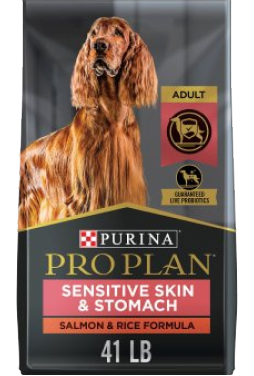
Raised Right Beef is one of 11 fresh recipes included in our review of the Raised Right product line.
Raised Right Beef derives the lions share of its animal protein from fresh beef. Dry matter label analysis reveals the recipe contains 61% protein, 24% fat and 8% estimated carbs… delivering a fat-to-protein ratio of about 39%.
One of the best fresh, human-grade dog foods on the market. Unusually wide recipe selection can be a major plus… especially for picky eaters. Highly recommended.
Read our review of the full Raised Right Dog Food (Fresh) range here
Main Ingredients Beef, beef heart, carrots, beef liver, cranberries Type Grain-free (carrots, cranberries) Protein Percentage 61% AAFCO Standards Maintenance Best For Adult dogs only -
5. We Feed Raw Turkey Patties
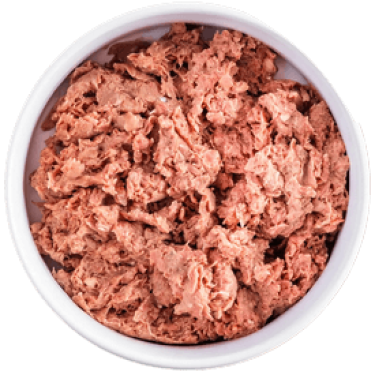
Turkey Patties is one of 6 frozen raw recipes included in our review of the We Feed Raw product line.
This We Feed Raw Turkey Patties derives most of its animal protein from turkey. Dry matter label analysis reveals the recipe contains 49% protein, 25% fat and 18% estimated carbs… producing a fat-to-protein ratio of about 52%.
High quality ingredients. Highly recommended.
Read our review of the full We Feed Raw Dog Food (Raw Frozen) range here
Main Ingredients Turkey Tails, turkey gizzards, turkey wings, turkey liver, WFR vitamin + mineral mix Type Grain-free Protein Percentage 49% AAFCO Standards All Life Stages Sample buyer review...
Read more buyer reviews at WeFeedRaw.com"I have been feeding my dogs We Feed Raw for 3 years now and they love their food, their coats are always shining. They are active, happy, healthy dogs."
-
6. Canidae Grain-Free Pure Limited Ingredient
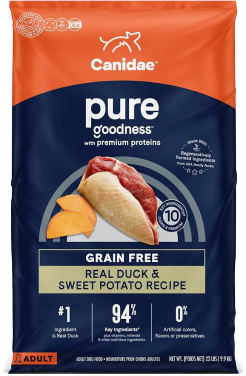
Real Salmon and Sweet Potato Recipe is one of 10 formulas included in our review of the Canidae Grain-Free Pure dry product line.
Canidae Grain-Free Pure Real Salmon and Sweet Potato gets the majority of its meat protein from fresh salmon, as well as salmon and menhaden fish meals. Our dry matter label analysis reveals the recipe contains 36% protein, 20% fat and 36% estimated carbs… creating a fat-to-protein ratio of about 56%.
A high-quality recipe ideal for adult dogs.
Read our review of the full Canidae Grain Free Pure Dog Food (Dry) range here
Main Ingredients Salmon, salmon meal, menhaden fish meal, sweet potatoes, peas Type Grain-free Protein Percentage 36% AAFCO Standards Maintenance Best For Adults only (not for puppies) -
7. Taste of the Wild Prey Limited Ingredient Dog Food
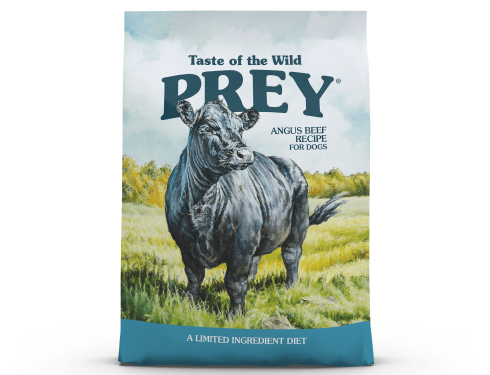
Angus Beef Recipe is one of 3 dry formulas included in our review of the Taste of the Wild Prey Limited Ingredient product line.
Taste of the Wild Prey Angus Beef receives most of its animal protein from fresh beef. Dry matter label analysis reveals the recipe contains 30% protein, 17% fat and 45% estimated carbs… which yields a fat-to-protein ratio of about 57%.
Highly recommended.
Read our review of the full Taste of the Wild Prey Dog Food (Dry) range here
Main Ingredients Beef, lentils, tomato pomace, chicken fat, natural flavor Type Grain-free Protein Percentage 30% AAFCO Standards All life stages Best For All adults + puppies -
8. Purina Pro Plan Veterinary Diets HA Chicken Flavor
Unrated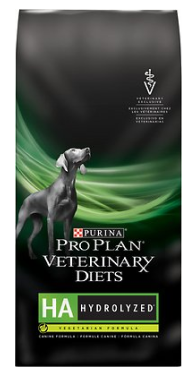
Chicken Flavor is one of 2 recipes included in our review of the Purina Pro Plan Veterinary Diets HA Dog Food dry product line.
Purina Pro Plan Veterinary Diets HA Chicken Flavor gets most of its protein from hydrolyzed soy protein isolate. Our dry matter label analysis reveals the recipe contains 20% protein, 11% fat and 61% estimated carbs… which creates a fat-to-protein ratio of about 53%.
An exceptional selection for sensitive dogs. Highly recommended.
Read our review of the full Purina Pro Plan Veterinary Diets HA Dog Food (Dry) range here
Main Ingredients Corn starch, hydrolyzed soy protein isolate, partially hydrogenated canola oil preserved with TBHQ, coconut oil, powdered cellulose Type Grain-free Protein Percentage 20% AAFCO Standards Maintenance Best For Adults only (not for puppies) -
9. Merrick Limited Ingredient Diet Dog Food
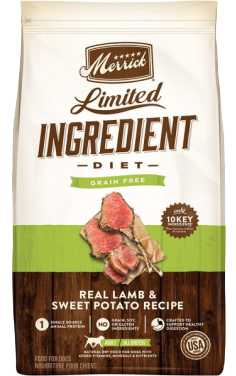
Real Turkey and Brown Rice is one of 4 wet recipes included in our review of the Merrick Limited Ingredient Diet wet product line.
This Merrick Limited Ingredient formula derives the bulk of its meat protein from fresh deboned turkey. Our dry matter label analysis reveals the recipe contains 36% protein, 27% fat and 28% estimated carbs… which results in a fat-to-protein ratio of about 75%.
A balanced, wet alternative to dry kibble. A practical option for those seeking to pin down a possible offending ingredient. Plus it’s available in 4 other featured proteins. Highly recommended.
Read our review of the full Merrick Limited Ingredient Diet Dog Food (Canned) range here
Main Ingredients Deboned turkey, turkey broth, turkey liver, brown rice, oatmeal Type Grain-inclusive (brown rice, oatmeal) Protein Percentage 36% AAFCO Standards Maintenance Best For Adults only (not for puppies) -
10. Royal Canin Veterinary Diets Hydrolyzed Protein Adult HP
Unrated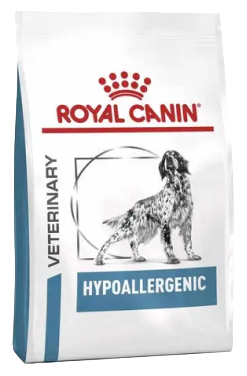
Royal Canin Veterinary Diets Hydrolyzed Protein Adult HP is one of 4 recipes included in our review of the Royal Canin Veterinary Diets Hydrolyzed Protein dry product line.
Royal Canin Veterinary Diets Hydrolyzed Protein draws the bulk of its protein from hydrolyzed soy protein. Our dry matter label analysis reveals the recipe contains 21% protein, 19% fat and 52% estimated carbs… producing a fat-to-protein ratio of about 89%.
A solid all life stages option for dogs with allergies.
Read our review of the full Royal Canin Veterinary Diet Hydrolyzed Protein Dog Food (Dry) range here
Main Ingredients Brewers rice, hydrolyzed soy protein, chicken fat, natural flavors, dried plain beet pulp Type Grain-inclusive (brewers rice) Protein Percentage 21% AAFCO Standards All life stages Best For All adults + small or medium breed puppies -
11. Hill's Prescription Diet Z/D Skin Food Sensitvities
Unrated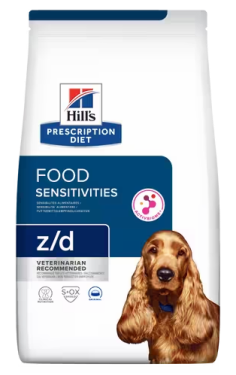
Z/D is one of 2 dry recipes included in our review of the Hill’s Prescription Skin Food Sensitivities product line.
This product gets the majority of its animal protein from chicken liver. Dry matter label analysis reveals the recipe contains 19% protein, 14% fat and 59% estimated carbs… yielding a fat-to-protein ratio of about 75%.
Hill’s Z/D is made with hydrolyzed protein derived from chicken to help avoid adverse food reactions and promote healthy skin.
A time-proven, hypoallergenic formula that’s been recommended by veterinary professionals nationwide for years. Ideal for dogs diagnosed with food and skin allergies. Highly recommended.
Read our review of the full Hill’s Prescription Diet Z/D Canine Dog Food (Dry) range here
Main Ingredients Corn starch, hydrolyzed chicken liver, powdered cellulose, soybean oil, calcium carbonate Type Grain-free Protein Percentage 19% AAFCO Standards Maintenance Best For Adults only, including seniors (not for puppies) -
12. Natural Balance Limited Ingredient Diets
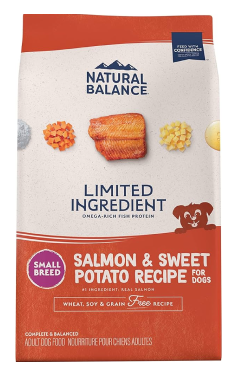
This Salmon and Brown Rice Formula is one of 26 recipes included in our review of the Natural Balance Limited Ingredient Diets dry product line.
This Natural Balance Limited Ingredient formula derives most of its animal protein from fresh salmon and fish meal. Our dry matter label analysis reveals the recipe contains 27% protein, 17% fat and 49% estimated carbs… which produces a fat-to-protein ratio of about 63%.
Enthusiastically recommended.
Main Ingredients Salmon, menhaden fish meal, brown rice, brewers rice, rice bran Type Grain-inclusive (brown rice, brewers rice) Protein Percentage 27% AAFCO Standards Maintenance Best For Adults only (not for puppies) -
13. Purina Pro Plan Sensitive Skin and Stomach
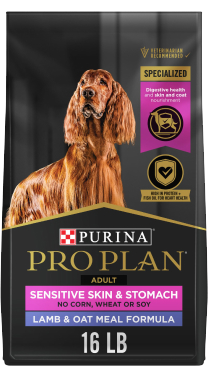
Sensitive Skin Salmon and Rice is one of 19 recipes included in our review of the Purina Pro Plan dry product line.
This Purina Pro Plan formula derives the bulk of its animal protein from fresh salmon. Dry matter label analysis reveals the recipe contains 30% protein, 18% fat and 44% estimated carbs… yielding a fat-to-protein ratio of about 62%.
We also note the inclusion of omega-3 and 6 fatty acids from sunflower and fish oils… designed to help support dry, itchy skin.
An exceptional over-the-counter, non-prescription dog food that may provide symptomatic relief from chronic skin allergies. Highly recommended.
Read our review of the full Purina Pro Plan Dog Food range here
Main Ingredients Salmon, barley, rice, oat meal, canola meal Type Includes grain (barley, rice, oat meal) Protein Percentage 30% AAFCO Standards Maintenance Best For Adults only (not for puppies) -
14. Zignature Turkey Formula Limited Ingredient Dog Food

Zignature Turkey is one of 13 wet dog food recipes included in our review of the Zignature canned product line.
Zignature Salmon extracts the bulk of its meat protein from fresh turkey. Our dry matter label analysis reveals the recipe contains 52% protein, 23% fat and 17% estimated carbs… creating a fat-to-protein ratio of about 43%.
An exceptional, simple ingredient formula. Recommended with confidence.
Read our review of the full Zignature Dog Food (Canned) range here
Main Ingredients Turkey, turkey broth, turkey liver, peas, turkey meal Type Grain-free Protein Percentage 52% AAFCO Standards All life stages Best For All adults + puppies
More Top Picks
To view more top dog foods by category… click the link below that best meets your personal feeding needs.
Here are the most frequently asked questions we get about feeding dogs with food allergies:
Frequently Asked Questions
How can I switch to a new food without making my dog sick?
In this video…
Dr. Gary Richter shares a simple feeding tip that can help lower your dog’s risk of getting sick when you switch to a new recipe designed to help with food allergies.
It’s best to switch your dog to a new food gradually.
Start by mixing 20% “new” with 80% “old” food. Then, slowly increase that amount to a full 100% over the next 8 to 9 days.
| Schedule | Old Food | New Food |
|---|---|---|
| Days 1 and 2 | 80% | 20% |
| Days 3 and 4 | 60% | 40% |
| Days 5 and 6 | 40% | 60% |
| Days 7 and 8 | 20% | 80% |
| Day 9 | 0% | 100% |
What are the most common causes of food allergies in dogs?
The 6 most common canine food allergens1 include…
- Beef
- Chicken
- Chicken egg
- Dairy
- Soy
- Wheat gluten
Keep in mind, dogs aren’t naturally more allergic to these items. It’s just that they are the ingredients most commonly found in many dog food recipes.
Which also makes them the ones dogs are most frequently allergic to.
What are other causes of allergies and dry itchy skin in dogs?
Dog food isn’t the only cause of dietary and skin allergies.
Truth is…
Food allergies account for just 10% of all canine allergies.2
They’re only the third most common cause, ranked well behind fleas and environmental allergies.
Yet food is the first to be blamed whenever a dog shows any sign of an allergic reaction, like dry itchy skin.
What's the difference between a food allergy and a food intolerance?
A food allergy occurs when a dog’s immune system identifies a particular ingredient as harmful.
And then creates defensive antibodies to fight the invading enemy (the food).
On the other hand…
A food intolerance is a digestive problem rather than an immune response.
An intolerance occurs when a dog’s digestive system is unable to digest a specific ingredient.
For example, lactose intolerance is a common condition in which a dog is unable to digest lactose (a sugar found in milk).
How do the symptoms of dog food allergy and intolerance compare?
The symptoms of an allergy can include skin rash, hives, itching, paw biting, obsessive licking and sometimes nausea or vomiting.
The signs of food intolerance include (mainly) digestive distress, gas, bloating, nausea, vomiting or diarrhea.
Again, let’s use milk as an example…
A milk intolerance would look more like gastric distress. This can include symptoms like gas, bloating or diarrhea.
However, a milk allergy would produce an immune reaction (for example, itching or a rash).






